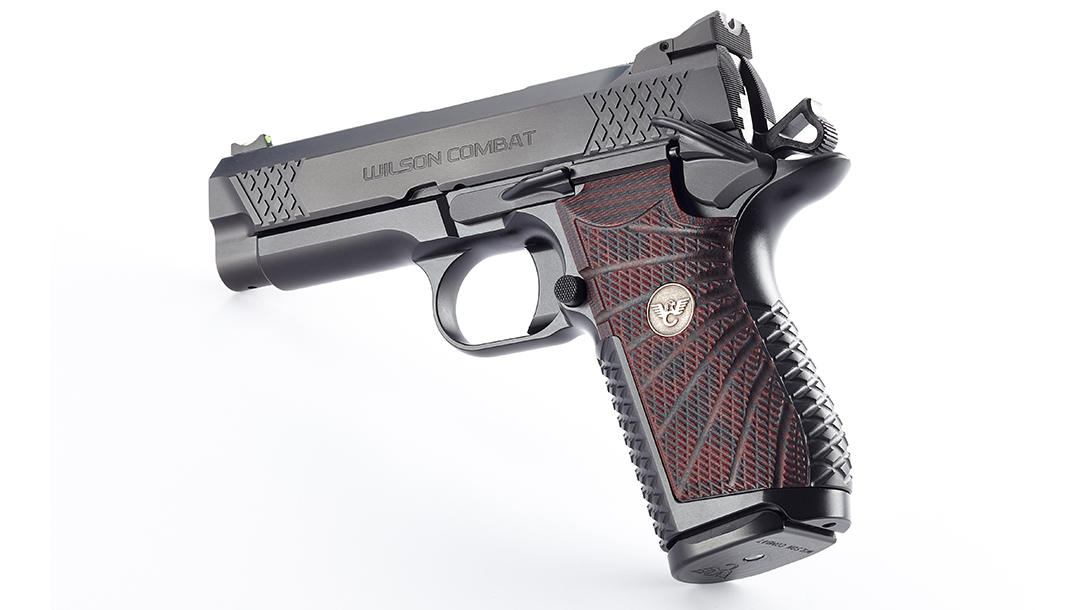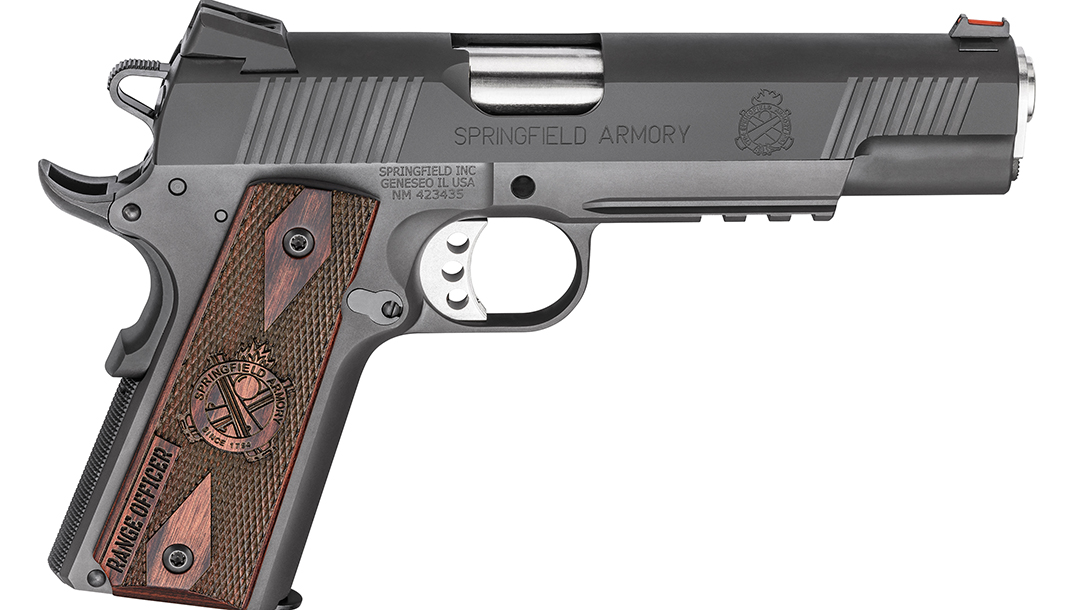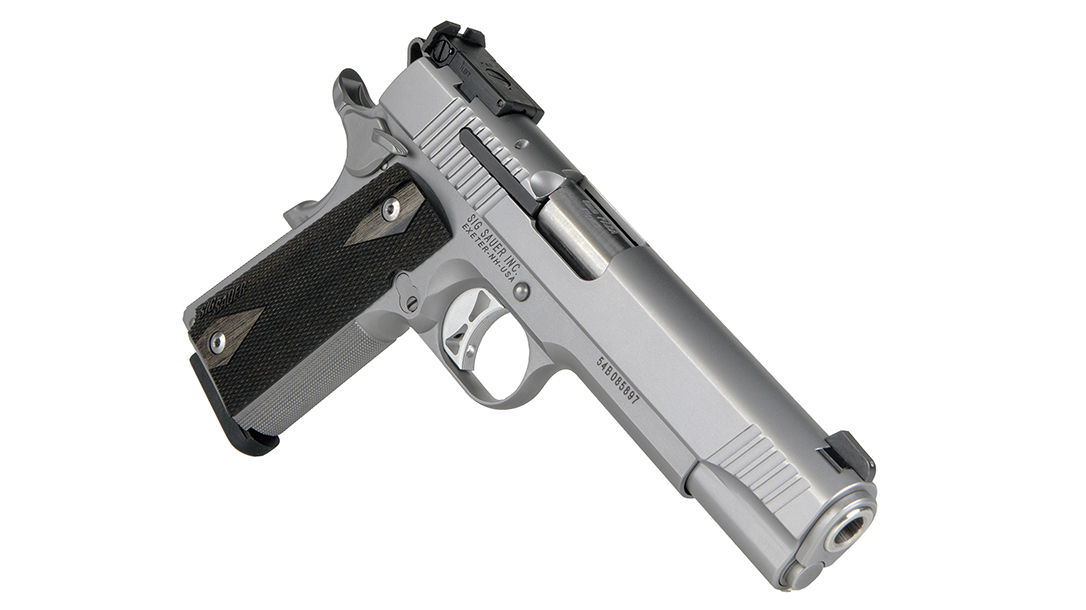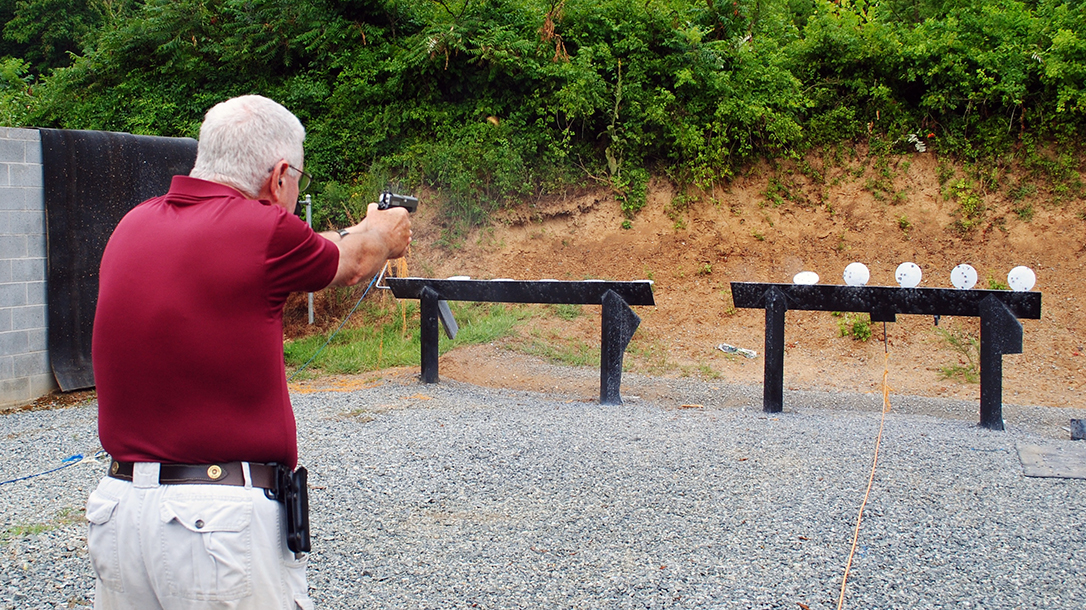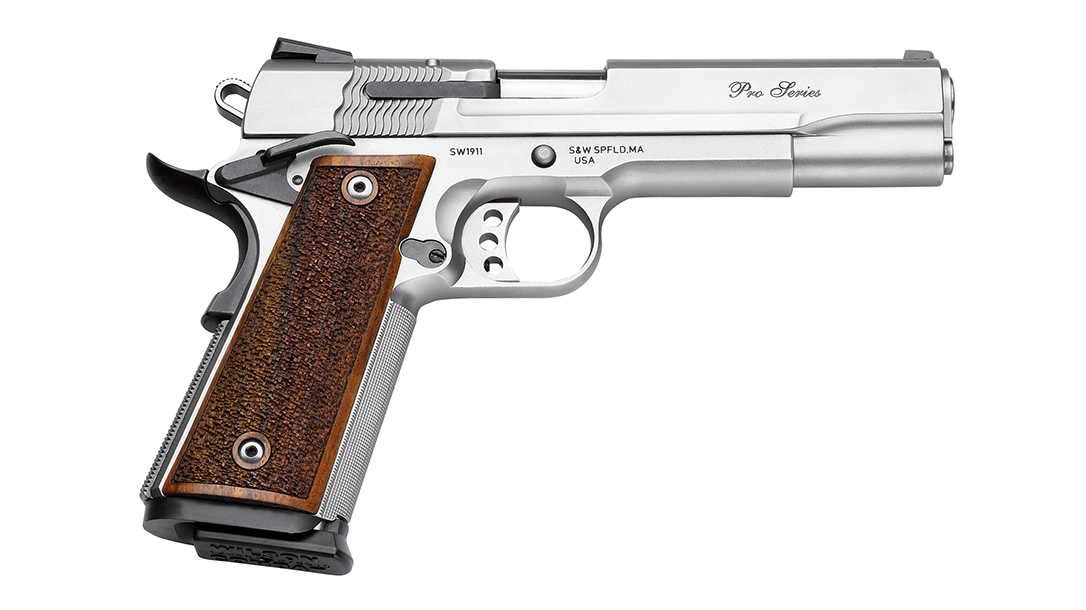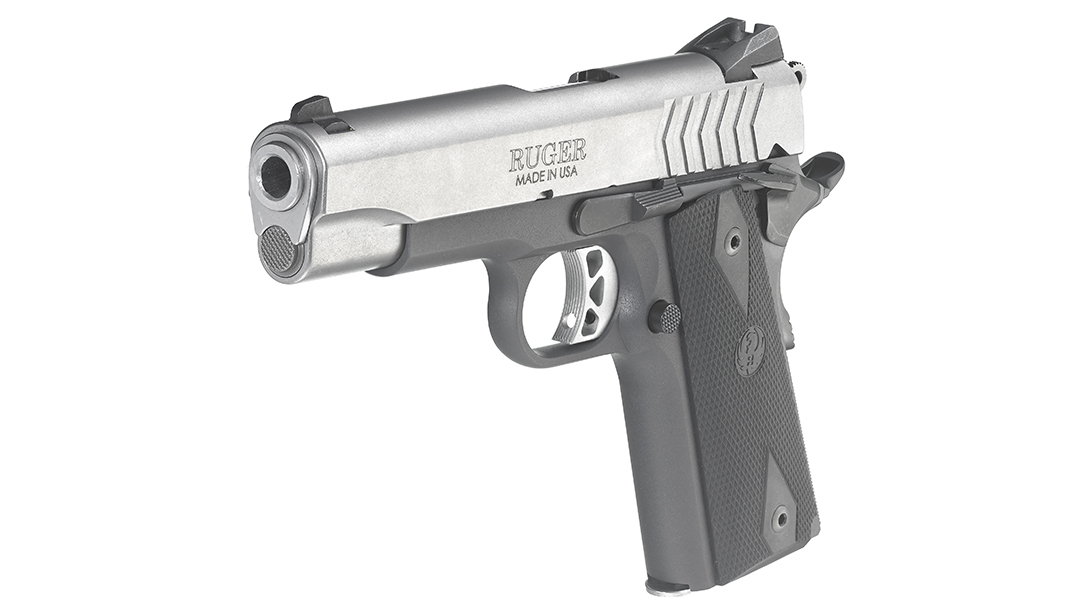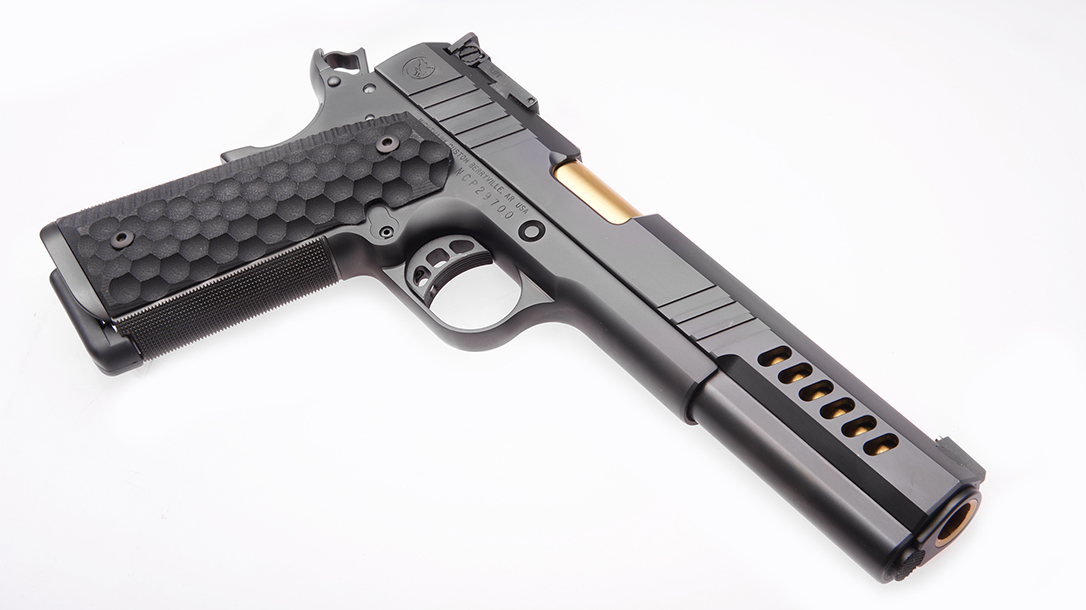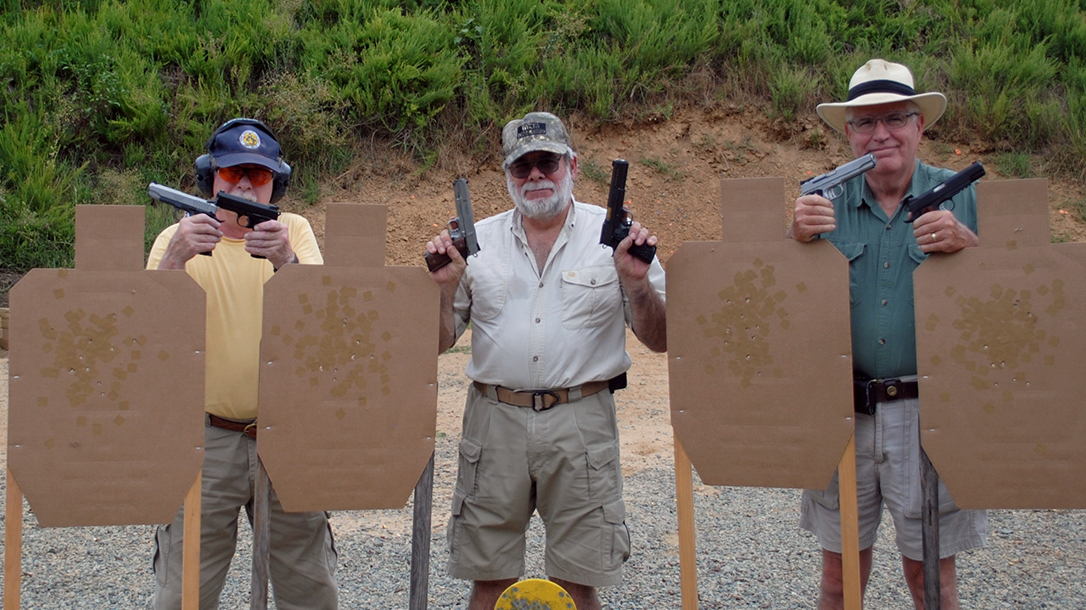Despite its age, the 1911’s popularity is greater now than at any time in its history. Over a dozen gun-makers in this country and overseas continue to produce it, and it has earned a reputation that ensures its position as one of the greatest combat handguns of all time. It is still the choice many armed professionals and competitive shooters around the world. Some of its more ardent supporters claim that the .45-caliber 1911 is the “perfect” combat pistol and brand anyone who disagrees a fool, if not a traitorous dog.
Note that I said, “.45-caliber 1911,” because what I am about to say may give some ardent supporters a case of the vapors. But just about every 1911 manufacturer now offers a version in 9mm.
Advertisement — Continue Reading Below
Does the Nine Make the Best 9mm 1911?
I don’t feel it is necessary to reiterate the myriad reasons for the 1911’s popularity — ergonomics and reliability being foremost — but a short defense of the 9mm will explain why I think it’s a perfect match for “Old Slabsides.”
First of all is performance. Thanks to the development of new propellants and projectiles, the on-target performance of the 9mm now equals that of larger-caliber cartridges. So much so that many U.S. law enforcement agencies, including the FBI, are currently replacing their larger-caliber service pistols with 9mms.
The 9mm generates less recoil than .40 S&W and .45 ACP cartridges. Less recoil makes training easier and allows for faster, more accurate shooting. The 9mm’s smaller size also allows a 1911 to carry more ammo without any increase in dimensions, including weight. When you add up these benefits, I firmly believe that a 9mm 1911 pistol is basically a win-win. If could be the best 1911.
Advertisement — Continue Reading Below
To test this theory, I sent off emails to manufacturers and received several 9mm 1911s that ran the gamut from compact to long-slide models. These included the Nighthawk Chairman, Ruger SR1911 Lightweight Commander, Sig Sauer 1911 Match Elite, Smith & Wesson SW1911 Pro Series, Springfield Armory Range Officer Operator and Wilson Combat EDC X9.
Meet the Fighters
While these pistols share similar features, each was also unique. First, the Ruger and Wilson utilize aluminum alloy rather than steel frames. The slides on the Ruger, S&W and Sig are made from stainless steel, while the others are forged.
Regarding barrel length, the Wilson sports a 4-inch tube while the Ruger comes with 4.25-inch barrel. The Sig, S&W and Springfield come with 5-inch barrels, and the Nighthawk stands out with its 6-inch barrel. It also boasts lightening cuts on both sides of the slide near the muzzle. These cuts keep the slide at the proper weight for reliable operation with 9mm loads.
Advertisement — Continue Reading Below
Their sights also varied. The Springfield and Wilson sport fiber-optic front sights. However, the Sig, S&W and Ruger have white-dot blades, and the Nighthawk sports a gold bead. At the rear, the Nighthawk and Sig come with adjustable sights, while the Ruger, S&W and Springfield have Novak fixed sights. The EDC X9 comes with Wilson’s U-notch Battlesight, which is adjustable for elevation.
Five of the pistols have checkered mainspring housings, with matching frontstraps on the Nighthawk, Sig and S&W. The Wilson features the company’s X-TAC treatment, which consists of crosscut grooves on the grips, frontstrap and mainspring housing.
All of the pistols have extended thumb safeties. Those on the Nighthawk, Ruger and Springfield are single-sided; the rest are ambidextrous. The Nighthawk and Wilson also have extended slide stop levers.
Advertisement — Continue Reading Below
Now the Wilson stands out because it does not have a grip safety. While some may bemoan this, I’m sure just as many will agree with me that the 1911’s grip safety is an unnecessary, even anachronistic, appendage.
Five of the 1911s have single-stack magazines containing nine or 10 rounds. However, the Wilson followed the beat of a different drummer with its 15-round, double-stack magazine.
Rules of the Ring
Before meeting my friends, Dick Jones and Richard Cole, for this shootout, I zeroed each pistol from an MTM K-Zone rest at 15 yards and was pleased to see that they were all capable of producing groups measuring 2 inches or less. I then field-stripped, cleaned and lubricated each pistol — the only maintenance they received the whole time.
Advertisement — Continue Reading Below
We decided to use timed drills to evaluate the six pistols, and Competition Electronics kindly provided us with a Pocket Pro shot timer. Anthony Welsch at the Target Barn gave us several IPSC cardboard targets, and once again, we used self-setting steel poppers from Birchwood Casey. The drills were simple:
Steel Plate Drill
| Paul | Richard | Dick | |
| Nighthawk | 5.88 | 6.97 | 7.08 |
| Ruger | 5.71 | 12 | 8.92 |
| Sig Sauer | 5.42 | 8.96 | 6.18 |
| Smith & Wesson | 5.36 | 7.11 | 5.35 |
| Springfield | 7.35 | 7.85 | 6.02 |
| Wilson Combat | 6.14 | 11.75 | 6.16 |
On the signal, the shooter engages a rack of six plates 8 yards from the shooting line. They then reload the pistol and repeat the drill three more times. Scoring includes the total time for each of the four runs, plus a five-second penalty for any plate left standing.
Paper/Popper/Paper Drill
| Paul | Richard | Dick | |
| Nighthawk | 11.89 | 13.69 | 10.98 |
| Ruger | 12.76 | 14.43 | 11.74 |
| Sig Sauer | 12.61 | 14.43 | 11.74 |
| Smith & Wesson | 11.22 | 13.75 | 11.59 |
| Springfield | 11.32 | 15.16 | 15.01 |
| Wilson Combat | 12.84 | 13.31 | 15.59 |
From 10 yards, the shooter engages two cardboard IPSC targets, then shoots the popper in between them down before engaging the remaining pair of targets with one round each. The popper must go down before engaging the remaining targets. They then perform a combat reload and reengage the targets. The drill is run two more times. Again, scoring includes the total time for each of the three runs, plus a five-second penalty for any miss.
Advertisement — Continue Reading Below
Steel El Presidente
| Paul | Richard | Dick | |
| Nighthawk | 12.10 | 14.49 | 11.03 |
| Ruger | 11.31 | 15.43 | 10.26 |
| Sig Sauer | 12.34 | 13.95 | 14.15 |
| Smith & Wesson | 13.02 | 13.75 | 9.58 |
| Springfield | 13.30 | 15.09 | 10.15 |
| Wilson Combat | 12.52 | 13.31 | 8.35 |
The shooter begins facing three steel targets 15 yards from the shooting line with a loaded pistol on a barrel in front of them. On the signal, they obtain the pistol and engage each steel target with two rounds, perform a combat reload and reengage them. The drill is repeated two more times. Scoring includes the total time for each of the three runs, plus a five-second penalty for any miss.
Except for the “El Presidente,” we began each of the drills from the low-ready position, and to level the playing field, the pistols were loaded with 10 rounds while all of the reload magazines contained nine. Each shooter fired a minimum of 90 rounds from each pistol for a minimum of 540 from the six firearms. Hornady, Sig Sauer and Winchester supplied 115-grain SXZ rounds, 115-grain FMJs and 115-grain XTPs, respectively. For easier reloading, Brownells provided a pair of UpLULA magazine loaders.
In-Depth Results
Afterwards, we graded each pistol on a 1 (worse) to 5 (best) scale in seven categories: reliability, ergonomics, trigger control, recoil control, sights, off-hand accuracy and reloading ease. These were then added together to give each pistol a final score in each category. If a gun malfunctioned, we would attempt to correct the problem and continue shooting. Of course, these results require a bit of an explanation.
Advertisement — Continue Reading Below
Reliability
We had a total of three mechanical malfunctions out of almost 2,000 rounds. One shooter had two failures to extract with the S&W and a single failure to feed with the Nighthawk, both early in the testing. This came as a bit of a shock as we all remembered the days when just about any out-of-the-box 1911 pistol required gunsmith tuning to make it run reliably. The S&W must have had a tight or rough chamber, as it took an inordinate amount of oomph to retract the slide and extract an unfired case.
Ergonomics
Since they’re all 1911s, we expected high scores in this category, and we were right. The Ruger and Springfield lost a few points, as two shooters did not care for their grip panels. We also felt that the Wilson’s lack of a grip safety was a major improvement and might be the “wave of the future.”
Trigger Control
Only the S&W garnered a perfect score in this category, with the Nighthawk right behind it. The other four all had heavier and/or grittier trigger pulls. We might have been overly critical, however, because we’re used to the crisp triggers on our customized 1911s.
Advertisement — Continue Reading Below
Recoil Control
As the two lightest guns, the Ruger and Wilson lost points in this category while the shooter who didn’t like the Springfield’s grips — well, he didn’t like them again. All three of us felt the checkered frontstraps on the Nighthawk, Sig and S&W were a major plus while the Wilson’s X-TAC frame really helped tame the recoil of a rather light pistol.
Sights
All three of us are vocal critics of the three-white-dot sighting arrangement that graces (curses?) most pistols these days. One shooter liked the Sig’s plain black rear sight and white-dot front. While the Springfield and Wilson’s fiber-optic front sights allowed for fast transitions between targets, one of us is color blind, so the Springfield’s red fiber optic appeared white to him. None of us cared for the Nighthawk’s gold bead front sight and believe a fiber optic would be a more practical choice.
Off-Hand Accuracy
All six pistols proved more than adequate when it came to the timed drills. I believe that the differences in scores were purely subjective depending on how the shooters expected them to perform.
Reloading Ease
The Nighthawk and S&W’s magazine well funnels, and the Wilson’s wide magazine well opening, allowed for fast, fumble-free reloads. This could not be said of the Ruger, Sig or Springfield, with their narrow, sharp-edged magazine well openings. Lastly, as the Sig and S&W got dirtier, magazines would sometimes fail to drop free and had to be manually extracted. Extended magazine releases would be a big plus on all of these guns, too.
| Nighthawk | Ruger | Sig Sauer | Smith & Wesson | Springfield | Wilson Combat | |
|---|---|---|---|---|---|---|
| Reliability | 15 | 15 | 15 | 14 | 15 | 15 |
| Ergonomics | 15 | 13 | 15 | 15 | 13 | 15 |
| Trigger Control | 14 | 12 | 12 | 15 | 12 | 15 |
| Recoil Control | 15 | 10 | 14 | 15 | 13 | 11 |
| Sights | 11 | 10 | 12 | 12 | 13 | 11 |
| Off-Hand Accuracy | 15 | 12 | 14 | 14 | 13 | 13 |
| Reloading Ease | 15 | 15 | 12 | 14 | 10 | 14 |
| TOTAL | 100 | 83 | 94 | 99 | 89 | 94 |
Note: A perfect score is 15 in each category for a total of 105 points.
Personal Feelings
As I usually do, I asked my two compadres which pistol they liked the best and why. Dick Jones chose the S&W, saying, “It just fit my hand better, I really appreciated the frame checkering, it had a nice trigger, and it’s a great deal for the price.”Note: 5 is a perfect score for each category for a total of 35 points
Richard Cole said, “While I really liked the Wilson’s X-TAC grip, I have to agree with Dick. The S&W just handled beautifully and could be reloaded smoothly. You just have to black out those damn white dots on the rear sight.”
As for me, I liked everything about the Nighthawk except the front sight. The longer barrel and slide provided a longer sight radius and recoil-dampening weight. The frame checkering and grips made it easier to control, and it came with a really nice trigger.
Well, there you have it. As you can see, you don’t need to be ashamed for owning (or wanting) a 9mm 1911. Hopefully this report won’t generate too many angry responses from the 9mm-hating traditionalists out there. We just wanted to see if we could find a best 1911 in 9mm.
For more information about these 1911s, please visit:
Ruger SR1911 Lightweight Commander — ruger.com
Sig Sauer 1911 Match Elite — sigsauer.com
Smith & Wesson SW1911 Pro Series — smith-wesson.com
Springfield Armory Range Officer Operator — springfield-armory.com
Wilson Combat EDC X9 — wilsoncombat.com

